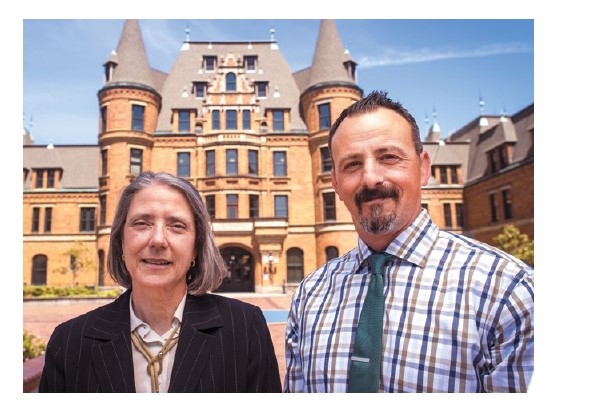Aligned Transitions
August 01, 2016
Tacoma’s systemic connections ease the journeys of students across the K-12 spectrum and beyond

You are a high school senior, living in poverty with a dream to go to college. You want it so badly that you can taste it. You are nervous about filling out your college applications because you don’t even know where to start. You feel paralyzed, questioning whether you did all the right things to make you a successful candidate. What if you aren’t ready? What if no one told you? You exhale.
What if you were surrounded by a community that designed a system to ensure that every transition you made in your prekindergarten through postsecondary experience intentionally placed you in a position to be successful? What would it look like to have this aligned system?
Easing Transitions
In the Tacoma, Wash., School District, we have designed such a system. It’s a system that dramatically increased high school graduation rates from 58 percent in 2010 to 82.5 percent in 2015. Our improved student graduation rate can be attributed to the district’s strategic plan, which specifies goals for our 29,300-student preK-12 school system.
Alignment across grade levels occurs because of specific priority goals outlined in our strategic plan along with accompanying benchmarks, allowing us to measure our success by analyzing the data. Because we focus on the individual needs of students, our efforts in the areas of effective instruction, specific program development and academic rigor are aligned across all grade levels, reducing the sharp transitions students experience when moving from one level to the next.
Additionally, we share our data with community partners and invite them to help us formulate solutions to some of the challenges. We have developed several strong partnerships to ensure student academic achievement is aligned throughout our education system.
Here’s an overview that starts with the end in mind.
From High School to College

Aligning access. The district’s partnership with University of Washington Tacoma includes regular monitoring discussions around the number of Tacoma students applying to the university, how many have been accepted and how to continue to reach out to potential applicants.
Admissions officers visit the district’s five comprehensive high schools, and we jointly celebrate a “signing day” to acknowledge each student and his or her acceptance by the university.
Removing financial barriers. Paying
for PSAT and SAT tests for all students supports their postsecondary applications. This ensures no barriers block students from entering college, and we use the test results to better prepare our students for the rigors of college and to recapture
credit for students who may have struggled earlier in their career.
Also, the University of Puget Sound has committed to meeting the financial needs of students who graduate from Tacoma Public Schools and meet admissions qualifications.
Aligning expectations. Tacoma Community College staff members in math and English meet regularly to discuss course expectations and a seamless transition between high school and college-level courses in these subjects. In addition, because the alignment of the courses is so well developed, the college will accept a passing grade in a senior English and/or math class as a way to place students in college-level courses.
Also, Tacoma Community College has hired some of our English and math teachers to teach “College in the High School” classes, enabling students to gain college credits as well as high school credit for the same class.
The school district has an opt-out policy (http://www.tacoma.k12.wa.us/Schools/advanced/Pages/default.aspx) for students who are at grade level and on target to graduate. This policy requires that students opt out of Advanced Placement courses and/or International Baccalaureate courses; otherwise, they are registered automatically for advanced classes. We believe all students should access rigorous classwork as needed preparation for college academics.
Measuring results. The process known as verified acceptance at next institution allows us to monitor the number of students who have been accepted into a postsecondary program whether a four-year university, a two-year college or a technical school. Each year, we see more students applying and being accepted into a postsecondary program.
From Middle to High School
High school credits for middle schoolers. The district offers Algebra 1 and Algebra 2, geometry and world languages at our nine middle schools. Accelerated students can take classes at the closest high school. In addition, we offer high school career and technical education courses in technology and engineering at middle schools.
We offer a summer program for incoming 9th graders where all students are automatically signed up for a summer transition program (with an opt-out provision) that not only familiarizes students with their new high school (lockers, classrooms, general logistics) but also teaches study skills to students in preparation for the work that will be required for on-time graduation from high school.
AVID (Advancement Via Individual Determination). Through the implementation of AVID strategies in grades 6-12 middle school and high school students districtwide learn strategies on note-taking and questioning techniques. Because of this coordination, students apply the skills learned in middle school to the high school setting.
From Elementary to Middle School
Throughout all content areas, we have designed a framework built around several transitional components.
Standards. Expectations are clear for what students will know and be able to do.
Assessment. Student needs are identified and monitored through various classroom-based assessments, while student, classroom and school needs are identified and monitored through district and statewide assessments.
Instruction and intervention. Research-based approaches to instruction and meeting individual students’ needs are implemented at the earliest ages to ensure students are ready to transition to the next level.
Leadership. Collaboration among leaders at the state, district, school and classroom levels is supported for shared ownership and clear direction for successful student transitions.
Systemwide commitment. Shared belief and commitment at every level are required for meeting the goals leading to the fulfillment of our mission.
From Home to Elementary
Building Connections. This is a program launched with our community childcare providers to strengthen understanding of the social-emotional needs of students in preparation for preschool and kindergarten. Common curriculum and instruction are discussed, and our elementary building administrators and district administrators participate in these conversations with community providers.
Family Support Specialist. Our Early Childhood Education and Assistance Program and Head Start program employ a staff member to support families with information about medical and dental screenings and home visits before the child enters school. Additionally, the district’s Birth to 3 Program has a family resource coordinator who does home visits, and provides special services for the family.
Child Find. This is a program that screens and evaluates newborns up to age 3 who may have developmental delays and provides advice to families on how to better support the educational needs of their children in advance of preschool.
Learning Supports
The Tacoma Whole Child Initiative follows a practical, hands-on approach to operationalizing the district’s vision into reality. We want each child to be healthy, safe, engaged, supported and challenged.
At the core of the initiative is a simple idea: Ensure each student is understood and has his or her needs met — not just academically, but socially and emotionally. The initiative considers the varied experiences students bring to class, whether they come from low-income backgrounds, have experienced trauma, are students of color or other factors. It aims to make students feel safe and welcome in their schools and throughout the community. By focusing on common language and equitable responses grounded in a growth mindset, students are able to transition from school to school.
As we enter another school year, we have a new group of students. We have another
opportunity, another chance, to improve our practices and align our supports. We have another opportunity to identify key transitions in a student’s development. The long-term goal is to build an educational experience that supports the whole
child. We want to identify the barriers and develop action steps to remove them to ease our students’ transitions. To do so will ensure their dreams have a solid chance of becoming a reality.
About the Authors
Toni Pace is assistant superintendent of K-12 support for Tacoma Public Schools in Tacoma, Wash. Joshua Garcia is deputy superintendent in Tacoma, Wash.
Advertisement
Advertisement
Advertisement
Advertisement

.png?sfvrsn=3d584f2d_3)

